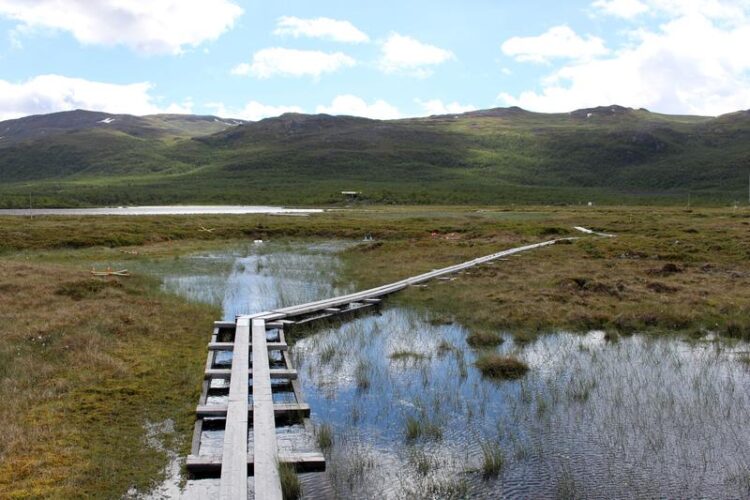Bacteria release climate-damaging carbon from thawing permafrost

Permafrost areas thaw out and become marshland.
Photo: Monique Patzner/University of Tübingen
Researchers from the Universities of Tübingen and Bristol show that iron minerals fail to trap the organic carbon; vast source of CO2 and methane not included in global warming forecasts.
Around a quarter of the ground in the northern hemisphere is permanently frozen. These areas are estimated to contain about twice as much carbon as the world’s current atmosphere. However, these permafrost soils are increasingly thawing out as the Earth becomes warmer. A University of Tübingen research team led by Professor Andreas Kappler, and Monique Patzner of the Center for Applied Geoscience, and Dr. Casey Bryce – now at the University of Bristol – has investigated the way this development affects the microorganisms in the soil. The results of their study have been published in Nature Communications.
The team worked on the assumption that thawing increases the availability of organic carbon for microorganisms to process, in turn releasing vast amounts of carbon dioxide and methane. These gases accelerate the greenhouse effect, leading to further permafrost thawing in a vicious cycle.
Rising temperatures lead to collapse of intact permafrost soils, resulting in landslides and the widespread formation of wetlands. In this latest study, the team investigated what happens to the carbon trapped in the soil when the permafrost thaws out. “The organic material naturally present in the samples accumulated as peat over thousands of years. With permafrost thaw, microbes become active and are able to decompose the peat,” says Kappler. “We also know that iron minerals preserve organic carbon from biodegradation in various environments – and thus they could be a carbon sink even after the permafrost has thawed.” The reactive iron is present as a kind of rust and might be expected to trap the organic material in what the scientists call a “rusty carbon sink.”
Investigations in Sweden
The team investigated the storage potential of the rusty carbon sink at a permafrost peatland at Stordalen mire, Abisko, Sweden. There, samples of the soil porewater and drill cores were taken of the active layer along a permafrost thaw gradient. The research team examined how much organic material was bound to reactive iron minerals, how stable these Fe-C-associations are with permafrost thaw, and whether the microorganisms present could use the material as a source of food and energy. The team also carried out experiments in the laboratory in Tübingen.
The team found that microorganisms are apparently able to use the iron as a food source, thereby releasing the bound organic carbon into the water in the soil. “That means the rusty carbon sink cannot prevent the organic carbon from escaping from the thawing permafrost,” says Andreas Kappler. “Based on data available from elsewhere in the northern hemisphere, we expect that our findings are applicable for permafrost environments worldwide,” says Casey Bryce, who headed the study.
The lead author of the publication, Monique Patzner, summarizes: “The rusty carbon sink is only found in intact permafrost soils; this sink is lost during permafrost thaw.” Now the researchers are seeking to find out how this facilitates greenhouse gas emissions and thus global warming. “It appears that the previously iron-bound carbon is highly bioavailable and therefore, bacteria could immediately metabolize it into greenhouse gas emissions,” says Patzner. “This is a process which is currently absent from climate-change prediction models and must be factored in.”
Wissenschaftliche Ansprechpartner:
University of Tübingen
Faculty of Science
Center for Applied Geoscience – Geomicrobiology
Professor Dr. Andreas Kappler
Phone +49 7071 29-74992
andreas.kappler[at]uni-tuebingen.de
Monique Patzner
Phone +49 7071 29-74715
monique-sezanne.patzner[at]student.uni-tuebingen.de
Dr. Casey Bryce
casey.bryce[at]bristol.ac.uk
Originalpublikation:
Monique S. Patzner, Carsten W. Mueller, Miroslava Malusova, Moritz Baur, Verena Nikeleit, Thomas Scholten, Carmen Hoeschen, James M. Byrne, Thomas Borch, Andreas Kappler & Casey Bryce: Iron mineral dissolution releases iron and associated organic carbon during permafrost thaw. Nature Communications, https://doi.org/10.1038/s41467-020-20102-6
Media Contact
All latest news from the category: Earth Sciences
Earth Sciences (also referred to as Geosciences), which deals with basic issues surrounding our planet, plays a vital role in the area of energy and raw materials supply.
Earth Sciences comprises subjects such as geology, geography, geological informatics, paleontology, mineralogy, petrography, crystallography, geophysics, geodesy, glaciology, cartography, photogrammetry, meteorology and seismology, early-warning systems, earthquake research and polar research.
Newest articles

Bringing bio-inspired robots to life
Nebraska researcher Eric Markvicka gets NSF CAREER Award to pursue manufacture of novel materials for soft robotics and stretchable electronics. Engineers are increasingly eager to develop robots that mimic the…

Bella moths use poison to attract mates
Scientists are closer to finding out how. Pyrrolizidine alkaloids are as bitter and toxic as they are hard to pronounce. They’re produced by several different types of plants and are…

AI tool creates ‘synthetic’ images of cells
…for enhanced microscopy analysis. Observing individual cells through microscopes can reveal a range of important cell biological phenomena that frequently play a role in human diseases, but the process of…





















